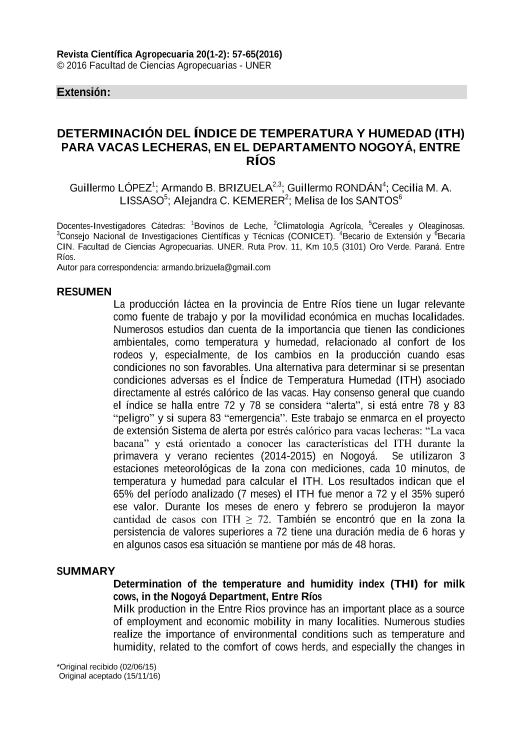Artículo
La producción láctea en la provincia de Entre Ríos tiene un lugar relevante
como fuente de trabajo y por la movilidad económica en muchas localidades.
Numerosos estudios dan cuenta de la importancia que tienen las condiciones
ambientales, como temperatura y humedad, relacionado al confort de los
rodeos y, especialmente, de los cambios en la producción cuando esas
condiciones no son favorables. Una alternativa para determinar si se presentan
condiciones adversas es el Índice de Temperatura Humedad (ITH) asociado
directamente al estrés calórico de las vacas. Hay consenso general que cuando
el índice se halla entre 72 y 78 se considera “alerta”, si está entre 78 y 83
“peligro” y si supera 83 “emergencia”. Este trabajo se enmarca en el proyecto
de extensión Sistema de alerta por estrés calórico para vacas lecheras: “La vaca
bacana” y está orientado a conocer las características del ITH durante la
primavera y verano recientes (2014-2015) en Nogoyá. Se utilizaron 3
estaciones meteorológicas de la zona con mediciones, cada 10 minutos, de
temperatura y humedad para calcular el ITH. Los resultados indican que el
65% del período analizado (7 meses) el ITH fue menor a 72 y el 35% superó
ese valor. Durante los meses de enero y febrero se produjeron la mayor
cantidad de casos con ITH ≥ 72. También se encontró que en la zona la
persistencia de valores superiores a 72 tiene una duración media de 6 horas y
en algunos casos esa situación se mantiene por más de 48 horas. Milk production in the Entre Rios province has an important place as a source of employment and economic mobility in many localities. Numerous studies realize the importance of environmental conditions such as temperature and humidity, related to the comfort of cows herds, and especially the changes in production when those conditions are not favorable. An alternative to determine if adverse conditions occur is the Temperature Humidity Index (THI) directly associated with heat stress in cows. There is general agreement that when the index is between 72 and 78 is considered "alert", “danger” if it is between 78 and 83 and “emergency” if it exceeds 83. This work is part of the extension project ‘Alert system heat stress for dairy cows: "The bacana cow" and is aimed to know the THI characteristics during the recent Spring and Summer (2014-2015) in Nogoyá. Three meteorological stations in the area were used with measurements every 10 minutes of temperature and humidity to calculate the THI. The results indicate that 65% of the analyzed period (7 months) the THI was under 72 and 35% exceeded that value. During the months of January and February most cases with ≥ 72 THI ocurred. We also found that in the persistent values above 72 have an average duration of 6 hours and in some cases it continues for more 48 hours.
Determinación del índice de temperatura y humedad (ITH) para vacas lecheras, en el Departamento Nogoyá, Entre Ríos
Título:
Determination of the temperature and humidity index (THI) for milk cows, in the Nogoyá Department, Entre Ríos
López, Guillermo; Brizuela, Armando Benito ; Rondan, Guillermo Antonio
; Rondan, Guillermo Antonio ; Lissaso, Cecilia M. A.; Kemerer, Alejandra Cecilia; de Los Santos, Cintia Melisa
; Lissaso, Cecilia M. A.; Kemerer, Alejandra Cecilia; de Los Santos, Cintia Melisa
 ; Rondan, Guillermo Antonio
; Rondan, Guillermo Antonio ; Lissaso, Cecilia M. A.; Kemerer, Alejandra Cecilia; de Los Santos, Cintia Melisa
; Lissaso, Cecilia M. A.; Kemerer, Alejandra Cecilia; de Los Santos, Cintia Melisa
Fecha de publicación:
12/2016
Editorial:
Universidad Nacional de Entre Ríos. Facultad de Ciencias Agropecuarias
Revista:
Revista Cientifica Agropecuaria
ISSN:
0329-3602
Idioma:
Español
Tipo de recurso:
Artículo publicado
Clasificación temática:
Resumen
Palabras clave:
Estrés calórico
,
Alerta
,
Caracterización ITH
,
Entre Ríos
Archivos asociados
Licencia
Identificadores
Colecciones
Articulos(SEDE CENTRAL)
Articulos de SEDE CENTRAL
Articulos de SEDE CENTRAL
Citación
López, Guillermo; Brizuela, Armando Benito; Rondan, Guillermo Antonio; Lissaso, Cecilia M. A.; Kemerer, Alejandra Cecilia; et al.; Determinación del índice de temperatura y humedad (ITH) para vacas lecheras, en el Departamento Nogoyá, Entre Ríos; Universidad Nacional de Entre Ríos. Facultad de Ciencias Agropecuarias; Revista Cientifica Agropecuaria; 20; 12-2016; 57-65
Compartir



